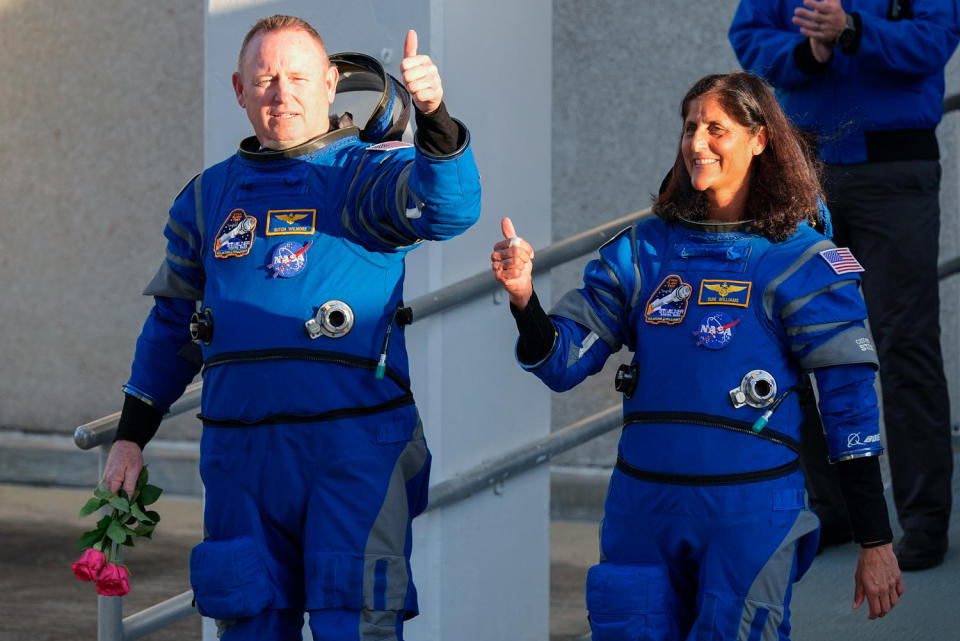NASA is considering keeping the two astronauts who carried the Boeing capsule to the International Space Station there until February because of problems the spacecraft experienced during flight.
The agency said Wednesday that it was still evaluating options for returning NASA astronauts Butch Wilmore and Suni Williams safely to Earth and that no plans had yet been made. But officials acknowledged more openly than before that they might decide to use a SpaceX capsule instead.
“Our primary option is to return Butch and Suni to Starliner,” Steve Stich, NASA’s Commercial Crew Program manager, said in a press briefing Wednesday. “But we’ve done the planning necessary to make sure our other options are open, and so we’re working with SpaceX to make sure they’re ready to respond.”
Wilmore and Williams arrived at the space station on June 6 on the first crewed test flight of Boeing’s Starliner capsule. The initial plan was for them to stay in space for about a week. But problems with the Starliner’s five thrusters and helium leaking from the capsule’s propulsion system stranded the astronauts there for more than two months while engineers on the ground collected data on the problems and tried to fix them.
The mission was intended to be the final step before the agency could certify Boeing to conduct routine crewed flights to and from the ISS, the fate of which is now up in the air.
NASA has not offered a timeline for when the astronauts might be able to return if they return in Boeing’s capsule, but Stich said a final decision would likely be made by mid-August.

Meanwhile, the launch of one of SpaceX’s Dragon capsules scheduled to send four new crew members to the space station later this month has been postponed to give NASA and Boeing more time to deal with the Starliner issues.
The SpaceX mission (known as Crew-9) was delayed by about a month. NASA officials said they may change the plan and send two crew members into space on that vehicle instead of four, then use the capsule to bring Wilmore and Williams home.
Ken Bowersox, associate administrator for NASA’s Space Operations Mission Directorate, said there are disagreements about how to get the astronauts home safely.
“I’ll admit that sometimes when we disagree, it’s not fun,” Bowersox said. “It can be painful to have those discussions, but that’s what makes us a good organization and that’s what’s going to lead us to a good decision when we get to that point in the future. And I don’t think we’re that far from making that decision.”
If Wilmore and Williams were to return home in a different vehicle, mission managers could make software adjustments to the Starliner that would allow it to depart the space station and return to Earth without a crew, Stich said.
Boeing officials did not attend the briefing, but a company representative said in a statement, “We remain confident in the capabilities and flight logic of Starliner.”
“Should NASA decide to change the mission, we will take the necessary steps to make Starliner suitable for an uncrewed return,” the statement said.
The thruster issues emerged as Starliner approached the space station in June, causing delays during the docking process. Meanwhile, helium leaks were on mission managers’ radar before liftoff. At the time, they said the leaks were unlikely to affect the mission or the safety of astronauts.
Engineers from NASA and Boeing are trying to replicate conditions in orbit in a test engine at the agency’s White Sands Test Facility in New Mexico. Mission managers also conducted two “hot fire tests” in space, firing the capsule’s thrusters in short bursts while it remained docked at the space station.
Stich said Wednesday that tests revealed that a small Teflon seal swells at high temperatures and may be partly responsible for the thruster problems. When the seal expands, it likely blocks the flow of propellant to the thrusters, he said.
More tests are needed to understand the possible blockages and why they were not detected in the latest hot-fire test. Last week, NASA reported that the thrusters used to maneuver the spacecraft in orbit and guide it into position before it plunges into Earth’s atmosphere appeared stable.
“This gives us a lot of confidence in the thrusters, but we can’t prove for sure that what we see in orbit is the same as on the ground,” Stich said.
The recent Starliner incident was a major blow to Boeing, especially since the program was already years behind schedule and more than $1.5 billion over budget before any astronauts could launch.
Boeing and SpaceX developed the space capsules as part of NASA’s Commercial Crew Program, an initiative launched more than a decade ago to support private companies building new spacecraft that would take astronauts to low-Earth orbit. The program comes after NASA’s space shuttles were retired.
SpaceX has been carrying astronauts to the International Space Station since 2020.
This article was originally published on NBCNews.com